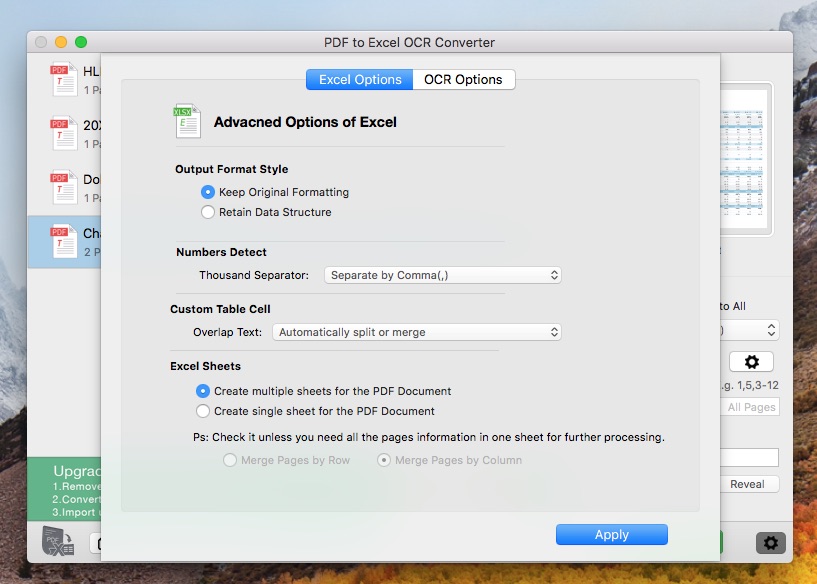

OCR PDF TO EXCEL PYTHON HOW TO
for i in range(len(df)):ĭf = tabula.read_pdf('file_path/file. How to install Aspose.Cloud SDKs,New Release of Aspose.OCR Cloud SDK for Python A Cloud SDK to Extract OCR or HOCR Text from Images in Python Using Powerful. To save these tables separately, you will have to use a for loop that will save each table in an Excel file. df = tabula.read_pdf('file_path/file.pdf', pages = 'all') The first element corresponds to the first table, the second to the second table, etc. Here, the variable df will be in fact a list of DataFrame. Ideal to convert them then in Excel file ! This function automatically detects the tables in a pdf and converts them into DataFrames. We load the libraries in our text editor : import tabula
OCR PDF TO EXCEL PYTHON CODE
The entire code : import tabula import pandas as pdĭf = tabula.read_pdf('file_path/file.pdf', pages = 'all')ĭf.to_excel('file_path/file.xlsx') Photo by Darius Cotoi on Unsplash PDF containing several tables Then convert it to an Excel file ! df.to_excel('file_path/file.xlsx') Data is processed solely on the API server and is powered by. import tabula Extaer los datos del pdf al DataFrame df tabula.readpdf ('inforatge.pdf') lo convierte en un csv llamdo out.csv codificado con utf-8 df.tocsv ('out.csv', sep'\t', encoding'utf-8') The. It can save data and files on your local server-based file storage or in Amazon AWS S3 storage. We can then check that the table has the expected shape. py that I call pdftocsv.py I put it in my Downloads / eltiempo folder and it is a file with the following code. Once the module is installed, you can convert PDF to text with Python by using the following code. To install PyPDF2, use the command line below: C:\Users\Admin>pip install PyPDF2. This PyPDF2 package can allow you to convert, split, merge, crop PDFs. The following command can be used for installing. This method will use an external module called PyPDF2 to convert PDF to text.

Ideal for converting them into Excel files! df = tabula.read_pdf('file_path/file.pdf', pages = 'all') pdf2image is a python library which converts PDF to a sequence of PIL Image objects using pdftoppm library. For example, if you downloaded it to your desktop, run cd. Launch the command line and navigate to the root folder.

I'll refer to it as root, but you can name the folder whatever you want.
OCR PDF TO EXCEL PYTHON DOWNLOAD
Then: Download this folder to your computer. This function automatically detects the tables in a pdf and converts them into DataFrames. First, install the tesseract OCR engine by downloading the installer. Then, we will read the pdf with the read_pdf() function of the tabula library. Some systems are capable of reproducing formatted output that closely approximates the original page including images, columns, and other non-textual components.Photo by Aurelien Romain on Unsplash PDF to Excel (one table only)įirst we load the libraries into our text editor : import tabula

You can toggle the visibility of this layer (this can be handy when debugging): You can see that borb re-inserted the postscript rendering command to ensure 'Hello World' is in the Document. It can convert PDF files to any other file format and works using a simple web-based API. This layer is named 'OCR by borb', and contains the rendering instructions borb re-inserted in the Document. Using PDFtablesapi one can do so because this module is very friendly and has a lot of features. There are 3 steps to set up your document parser. This is another way to make use of Python and its excellent set of libraries to make Excel files from PDF documents. Advanced systems capable of producing a high degree of recognition accuracy for most fonts are now common, and with support for a variety of digital image file format inputs. Docparser identifies and extracts data from Word, PDF, and image-based documents using Zonal OCR technology, advanced pattern recognition, and the help of anchor keywords. OCR is a field of research in pattern recognition, artificial intelligence and computer vision.Early versions needed to be trained with images of each character, and worked on one font at a time. Optical character recognition or optical character reader (OCR) is the electronic or mechanical conversion of images of typed, handwritten or printed text into machine-encoded text, whether from a scanned document, a photo of a document, a scene-photo (for example the text on signs and billboards in a landscape photo) or from subtitle text superimposed on an image (for example from a television broadcast).Widely used as a form of data entry from printed paper data records – whether passport documents, invoices, bank statements, computerized receipts, business cards, mail, printouts of static-data, or any suitable documentation – it is a common method of digitizing printed texts so that they can be electronically edited, searched, stored more compactly, displayed on-line, and used in machine processes such as cognitive computing, machine translation, (extracted) text-to-speech, key data and text mining.


 0 kommentar(er)
0 kommentar(er)
